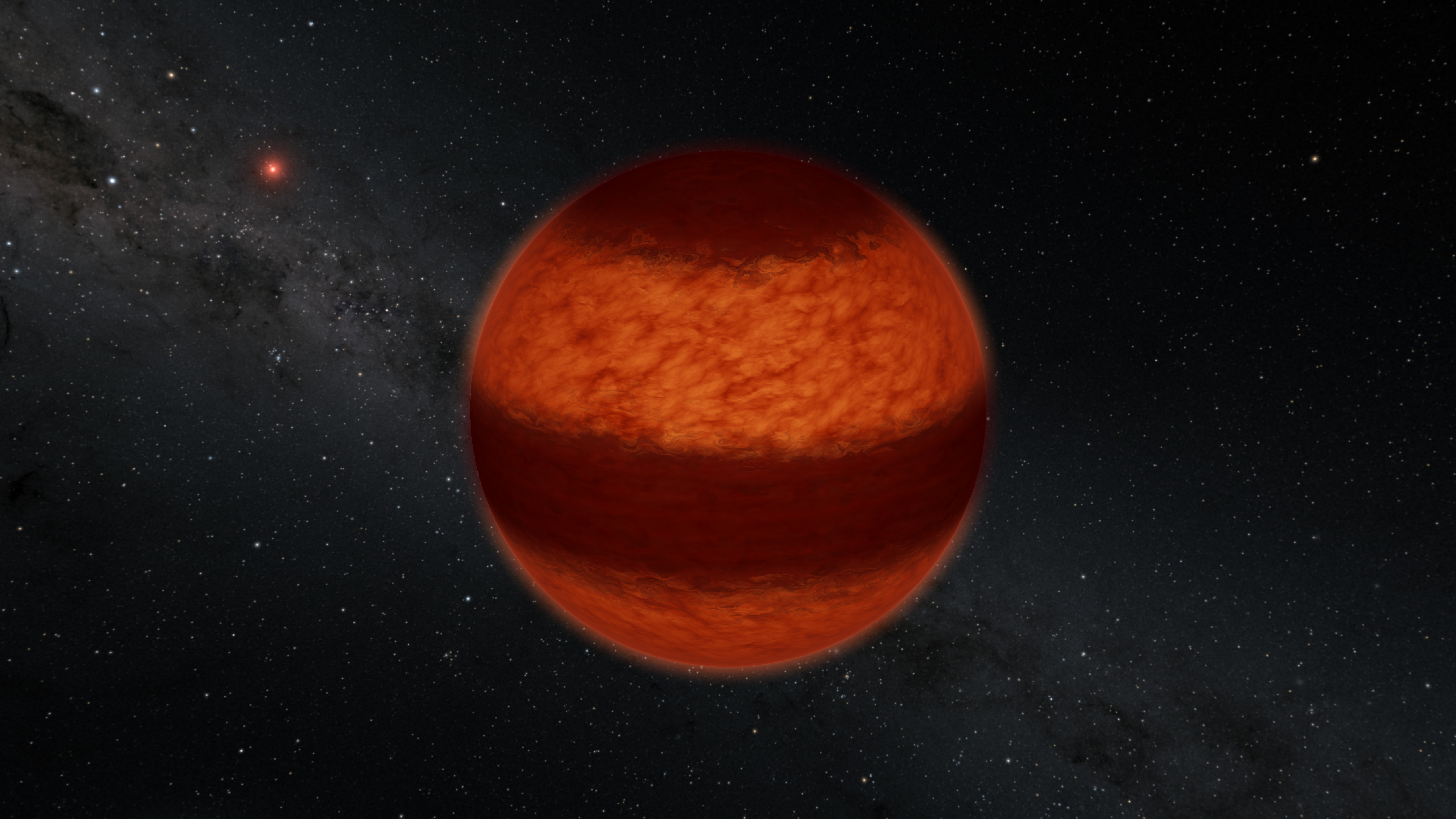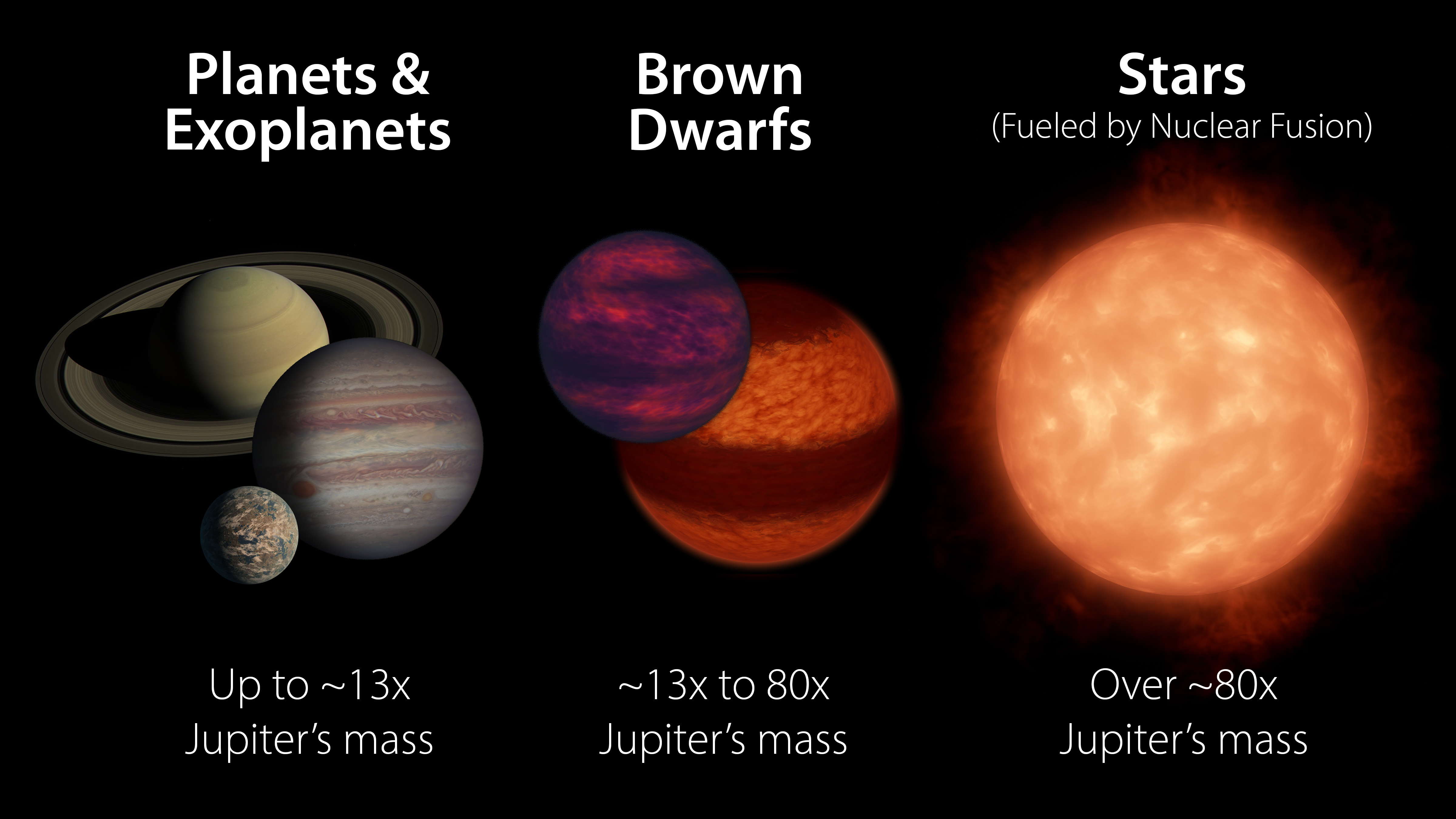
Bold banding may be a common feature of brown dwarf skies.
Scientists have spotted evidence of Jupiter-like stripes in the thick atmosphere of a nearby brown dwarf, a new study reports — and this evidence was gathered in a novel way.
Brown dwarfs are bigger than planets but not big enough to host fusion reactions in their interiors. For this reason, these curious objects are also known as "failed stars."
Related: Wind speed of a brown dwarf measured for 1st time
NASA's recently retired Spitzer Space Telescope previously detected banding patterns on multiple brown dwarfs, by tracking in detail how the objects' brightness varied over time. But in this new study, scientists inferred banding via polarimetry, the measurement of polarized light.
Polarized light oscillates in the same direction rather than in multiple, random avenues the way "normal" light does. Polarimetric instruments take advantage of this alignment, much as polarized sunglasses do to reduce the glare of light from Earth's star.
The study team used a polarimetric instrument on the European Southern Observatory's Very Large Telescope (VLT) in Chile to study the brown dwarf Luhman 16A, which is about 30 times heftier than Jupiter. The failed star is part of a brown-dwarf binary; it and its similar-sized partner, Luhman 16B, are the nearest such pair to Earth, a mere 6 light-years away.
Get the Space.com Newsletter
Breaking space news, the latest updates on rocket launches, skywatching events and more!
The VLT instrument, known as NaCo, detected an excess of polarization in the brown dwarf's light. That's a strong indication of atmospheric banding, researchers said. After all, the light was unpolarized when it was first emitted deep within Luhman 16A, becoming polarized by scattering off haze particles high in the brown dwarf's skies. In a uniform, unbanded atmosphere, this polarization would average out into an unpolarized glow, Caltech representatives explained in a video about the new results.

The scientists further interpreted the VLT observations using sophisticated computer models of Luhman 16A's thick atmosphere. The combined work suggests that the brown dwarf is striped, perhaps with two major, broad bands, researchers said.
"Polarimetry is the only technique that is currently able to detect bands that don't fluctuate in brightness over time," study lead author Maxwell Millar-Blanchaer, a postdoctoral astronomy researcher at the California Institute of Technology (Caltech) in Pasadena, said in a statement. "This was key to finding the bands of clouds on Luhman 16A, on which the bands do not appear to be varying."
The team's models also show that Luhman 16A probably has patches of very turbulent weather, as Jupiter and other gas-giant planets do.
"We think these storms can rain things like silicates or ammonia," study co-author Julien Girard, of the Space Telescope Science Institute in Baltimore, said in the same statement. "It's pretty awful weather, actually."
The new study marks the first time polarimetry has been used to understand clouds on an object beyond the solar system, team members said. Similar techniques can be used to study other brown dwarfs, and next-generation telescopes in space and on the ground could bring exoplanets into play as well. Polarimetry can help characterize planetary surfaces, potentially allowing scientists to spot liquid water on some alien worlds, study team members said.
"Polarimetry is receiving renewed attention in astronomy," co-author Dimitri Mawet, an astronomy professor at Caltech and a senior research scientist at the Jet Propulsion Laboratory, which Caltech manages for NASA, said in the same statement.
"Polarimetry is a very difficult art, but new techniques and data analysis methods make it more precise and sensitive than ever before, enabling groundbreaking studies on everything from distant supermassive black holes, newborn and dying stars, brown dwarfs and exoplanets, all the way down to objects in our own solar system," Mawet said.
The new study has been accepted for publication in The Astrophysical Journal.
- Brown dwarfs: the coolest stars or the hottest planets?
- Rare double brown dwarf eclipse spotted in surprise discovery
- Amazing space views of ESO's Very Large Telescope (photos)
Mike Wall is the author of "Out There" (Grand Central Publishing, 2018; illustrated by Karl Tate), a book about the search for alien life. Follow him on Twitter @michaeldwall. Follow us on Twitter @Spacedotcom or Facebook.
OFFER: Save 45% on 'All About Space' 'How it Works' and 'All About History'!
For a limited time, you can take out a digital subscription to any of our best-selling science magazines for just $2.38 per month, or 45% off the standard price for the first three months.
Join our Space Forums to keep talking space on the latest missions, night sky and more! And if you have a news tip, correction or comment, let us know at: community@space.com.

Michael Wall is a Senior Space Writer with Space.com and joined the team in 2010. He primarily covers exoplanets, spaceflight and military space, but has been known to dabble in the space art beat. His book about the search for alien life, "Out There," was published on Nov. 13, 2018. Before becoming a science writer, Michael worked as a herpetologist and wildlife biologist. He has a Ph.D. in evolutionary biology from the University of Sydney, Australia, a bachelor's degree from the University of Arizona, and a graduate certificate in science writing from the University of California, Santa Cruz. To find out what his latest project is, you can follow Michael on Twitter.
-
rod Luhman 16A and B are an interesting and well studied binary brown dwarf system. http://exoplanet.eu/catalog/luhman_16_a/, this shows the pair have orbital period about 27.5 years. Astrometry was used to determine accurate distance and masses for the pair too from Gaia DR2, https://www.aanda.org/articles/aa/abs/2018/10/aa33626-18/aa33626-18.htmlReply
"Using Gaia DR2 as astrometric reference field, we derived the absolute proper motion and updated the absolute parallax of the binary to 501.557 ± 0.082 mas. We refined the individual dynamical masses of LUH 16 to 33.5 ± 0.3 M Jup (component A) and 28.6 ± 0.3 M Jup (component B), which corresponds to a relative precision of ∼1% and is three to four times more precise than previous estimates."
A parallax of 501.557 mas is 6.5 LY distance or 1.994 pc. Some cool, geeky stats :)










